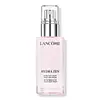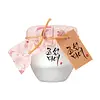What's inside
What's inside
 Key Ingredients
Key Ingredients

 Benefits
Benefits

 Concerns
Concerns

 Ingredients Side-by-side
Ingredients Side-by-side

Water
Skin ConditioningGlycerin
HumectantPentylene Glycol
Skin ConditioningOctyldodecanol
EmollientButylene Glycol
HumectantCaprylic/Capric Triglyceride
MaskingButyrospermum Parkii Butter
Skin ConditioningSimmondsia Chinensis Seed Oil
EmollientBeheneth-10
EmulsifyingSqualane
EmollientGlycol Palmitate
EmulsifyingPCA
HumectantAlanine
MaskingCocos Nucifera Oil
MaskingTocopherol
AntioxidantMacadamia Ternifolia Seed Oil
EmollientHydroxyacetophenone
AntioxidantSodium Polyacrylate
AbsorbentSodium Hyaluronate
HumectantSodium PCA
HumectantSodium Lactate
BufferingPaeonia Suffruticosa Root Extract
Skin ProtectingPhenylalanine
MaskingArginine
MaskingHelianthus Annuus Seed Oil
EmollientValine
MaskingPalmitoyl Tripeptide-8
Skin ConditioningXanthan Gum
EmulsifyingMenthol
MaskingAloe Barbadensis Leaf Juice Powder
Skin ConditioningPropylene Glycol
HumectantProline
Skin ConditioningIsoleucine
Skin ConditioningAspartic Acid
MaskingCoriandrum Sativum Fruit Oil
MaskingSorbitol
HumectantSerine
MaskingThreonine
Passiflora Edulis Seed Oil
EmollientRosa Gallica Flower Extract
AstringentHistidine
HumectantCitric Acid
BufferingPrunus Armeniaca Kernel Oil
MaskingDextran
Glycine
BufferingParfum
MaskingWater, Glycerin, Pentylene Glycol, Octyldodecanol, Butylene Glycol, Caprylic/Capric Triglyceride, Butyrospermum Parkii Butter, Simmondsia Chinensis Seed Oil, Beheneth-10, Squalane, Glycol Palmitate, PCA, Alanine, Cocos Nucifera Oil, Tocopherol, Macadamia Ternifolia Seed Oil, Hydroxyacetophenone, Sodium Polyacrylate, Sodium Hyaluronate, Sodium PCA, Sodium Lactate, Paeonia Suffruticosa Root Extract, Phenylalanine, Arginine, Helianthus Annuus Seed Oil, Valine, Palmitoyl Tripeptide-8, Xanthan Gum, Menthol, Aloe Barbadensis Leaf Juice Powder, Propylene Glycol, Proline, Isoleucine, Aspartic Acid, Coriandrum Sativum Fruit Oil, Sorbitol, Serine, Threonine, Passiflora Edulis Seed Oil, Rosa Gallica Flower Extract, Histidine, Citric Acid, Prunus Armeniaca Kernel Oil, Dextran, Glycine, Parfum
Water
Skin ConditioningGlycerin
HumectantButylene Glycol
HumectantNiacinamide
SmoothingDipentaerythrityl Hexa C5-9 Acid Esters
Skin ConditioningSodium Hyaluronate
HumectantXanthan Gum
EmulsifyingCyclopentasiloxane
EmollientCyclohexasiloxane
EmollientPolyacrylate-13
Polyisobutene
Polysorbate 20
EmulsifyingHydrogenated Lecithin
EmulsifyingC14-28 Alkyl Acid
Stearyl Alcohol
EmollientBehenyl Alcohol
EmollientDimethicone/Vinyl Dimethicone Crosspolymer
Skin ConditioningDimethicone
EmollientAdenosine
Skin ConditioningGlyceryl Stearate Se
EmulsifyingCetearyl Alcohol
EmollientPolyglyceryl-3 Methylglucose Distearate
EmulsifyingCetyl PEG/PPG-10/1 Dimethicone
EmulsifyingStearic Acid
CleansingTocopheryl Acetate
AntioxidantSodium Polyacrylate
AbsorbentOlea Europaea Fruit Oil
MaskingHelianthus Annuus Seed Oil
EmollientCentella Asiatica Extract
CleansingHippophae Rhamnoides Oil
EmollientArgania Spinosa Kernel Oil
EmollientButyrospermum Parkii Butter
Skin ConditioningCeramide NP
Skin ConditioningTrehalose
HumectantCalendula Officinalis Flower Extract
MaskingCaprylhydroxamic Acid
1,2-Hexanediol
Skin ConditioningRaphanus Sativus Leaf Extract
HumectantOryza Sativa Bran Extract
Skin ConditioningCucurbitaceae Extract
Skin ConditioningOrchid Extract
Skin ConditioningHoney Extract
HumectantPanax Ginseng Root Extract
EmollientCarthamus Tinctorius Seed Oil
MaskingPhytosphingosine
Skin ConditioningCeteareth-20
CleansingGlyceryl Citrate/Lactate/Linoleate/Oleate
EmulsifyingParfum
MaskingWater, Glycerin, Butylene Glycol, Niacinamide, Dipentaerythrityl Hexa C5-9 Acid Esters, Sodium Hyaluronate, Xanthan Gum, Cyclopentasiloxane, Cyclohexasiloxane, Polyacrylate-13, Polyisobutene, Polysorbate 20, Hydrogenated Lecithin, C14-28 Alkyl Acid, Stearyl Alcohol, Behenyl Alcohol, Dimethicone/Vinyl Dimethicone Crosspolymer, Dimethicone, Adenosine, Glyceryl Stearate Se, Cetearyl Alcohol, Polyglyceryl-3 Methylglucose Distearate, Cetyl PEG/PPG-10/1 Dimethicone, Stearic Acid, Tocopheryl Acetate, Sodium Polyacrylate, Olea Europaea Fruit Oil, Helianthus Annuus Seed Oil, Centella Asiatica Extract, Hippophae Rhamnoides Oil, Argania Spinosa Kernel Oil, Butyrospermum Parkii Butter, Ceramide NP, Trehalose, Calendula Officinalis Flower Extract, Caprylhydroxamic Acid, 1,2-Hexanediol, Raphanus Sativus Leaf Extract, Oryza Sativa Bran Extract, Cucurbitaceae Extract, Orchid Extract, Honey Extract, Panax Ginseng Root Extract, Carthamus Tinctorius Seed Oil, Phytosphingosine, Ceteareth-20, Glyceryl Citrate/Lactate/Linoleate/Oleate, Parfum
 Reviews
Reviews

Alternatives
Ingredients Explained
These ingredients are found in both products.
Ingredients higher up in an ingredient list are typically present in a larger amount.
Butylene Glycol (or BG) is used within cosmetic products for a few different reasons:
Overall, Butylene Glycol is a safe and well-rounded ingredient that works well with other ingredients.
Though this ingredient works well with most skin types, some people with sensitive skin may experience a reaction such as allergic rashes, closed comedones, or itchiness.
Learn more about Butylene GlycolThis ingredient is also known as shea butter. It is an effective skin hydrator and emollient.
Emollients help soothe and soften your skin. It does this by creating a protective film on your skin. This barrier helps trap moisture and keeps your skin hydrated. Emollients may be effective at treating dry or itchy skin.
Shea butter is rich in antioxidants. Antioxidants help fight free-radicals, or molecules that may harm the body. It is also full of fatty acids including stearic acid and linoleic acid. These acids help replenish the skin and keep skin moisturized.
While Shea Butter has an SPF rating of about 3-4, it is not a sunscreen replacement.
Shea butter may not be fungal acne safe. We recommend speaking with a professional if you have any concerns.
Learn more about Butyrospermum Parkii ButterGlycerin is already naturally found in your skin. It helps moisturize and protect your skin.
A study from 2016 found glycerin to be more effective as a humectant than AHAs and hyaluronic acid.
As a humectant, it helps the skin stay hydrated by pulling moisture to your skin. The low molecular weight of glycerin allows it to pull moisture into the deeper layers of your skin.
Hydrated skin improves your skin barrier; Your skin barrier helps protect against irritants and bacteria.
Glycerin has also been found to have antimicrobial and antiviral properties. Due to these properties, glycerin is often used in wound and burn treatments.
In cosmetics, glycerin is usually derived from plants such as soybean or palm. However, it can also be sourced from animals, such as tallow or animal fat.
This ingredient is organic, colorless, odorless, and non-toxic.
Glycerin is the name for this ingredient in American English. British English uses Glycerol/Glycerine.
Learn more about GlycerinHelianthus Annuus Seed Oil is the oil derived from the seeds of a Sunflower. Sunflower seed oil is non-fragrant. It is an emollient, meaning it helps to soften the skin.
Sunflower seed oil contains many fatty acids. The fatty acids found in sunflower seeds include (from highest amount to least): linoleic acid, myristic acid, palmitic acid, stearic acid, arachidic acid, oleic acid, and linolenic acid.
These fatty acids help the skin create ceramides. Ceramides play a role in repairing the skin barrier.
Helianthus Annuus Seed Oil helps moisturize the skin. This in turn helps the skin look more rejuvenated and smoother.
Sunflowers are rich in vitamin E.
Historians believe Indigenous cultures of North America domesticated sunflowers before corn. Thus they relied on sunflower oil for a variety of uses. One such use is moisturizing skin and hair.
Sunflower seed oil may not be fungal acne safe. We recommend speaking with a professional if you have any concerns.
Learn more about Helianthus Annuus Seed OilParfum is a catch-all term for an ingredient or more that is used to give a scent to products.
Also called "fragrance", this ingredient can be a blend of hundreds of chemicals or plant oils. This means every product with "fragrance" or "parfum" in the ingredients list is a different mixture.
For instance, Habanolide is a proprietary trade name for a specific aroma chemical. When used as a fragrance ingredient in cosmetics, most aroma chemicals fall under the broad labeling category of “FRAGRANCE” or “PARFUM” according to EU and US regulations.
The term 'parfum' or 'fragrance' is not regulated in many countries. In many cases, it is up to the brand to define this term.
For instance, many brands choose to label themselves as "fragrance-free" because they are not using synthetic fragrances. However, their products may still contain ingredients such as essential oils that are considered a fragrance by INCI standards.
One example is Calendula flower extract. Calendula is an essential oil that still imparts a scent or 'fragrance'.
Depending on the blend, the ingredients in the mixture can cause allergies and sensitivities on the skin. Some ingredients that are known EU allergens include linalool and citronellol.
Parfum can also be used to mask or cover an unpleasant scent.
The bottom line is: not all fragrances/parfum/ingredients are created equally. If you are worried about fragrances, we recommend taking a closer look at an ingredient. And of course, we always recommend speaking with a professional.
Learn more about ParfumSodium Hyaluronate is hyaluronic acid's salt form. It is commonly derived from the sodium salt of hyaluronic acid.
Like hyaluronic acid, it is great at holding water and acts as a humectant. This makes it a great skin hydrating ingredient.
Sodium Hyaluronate is naturally occurring in our bodies and is mostly found in eye fluid and joints.
These are some other common types of Hyaluronic Acid:
Learn more about Sodium HyaluronateSodium Polyacrylate is the sodium salt of polyacrylic acid. It is used as an absorber, emollient, and stabilizer.
This ingredient is a super-absorbent polymer - meaning it can absorb 100 to 1000 times its mass in water. As an emollient, Sodium Polyacrylate helps soften and soothe skin. Emollients work by creating a barrier to trap moisture in. This helps keep your skin hydrated.
Water. It's the most common cosmetic ingredient of all. You'll usually see it at the top of ingredient lists, meaning that it makes up the largest part of the product.
So why is it so popular? Water most often acts as a solvent - this means that it helps dissolve other ingredients into the formulation.
You'll also recognize water as that liquid we all need to stay alive. If you see this, drink a glass of water. Stay hydrated!
Learn more about WaterXanthan gum is used as a stabilizer and thickener within cosmetic products. It helps give products a sticky, thick feeling - preventing them from being too runny.
On the technical side of things, xanthan gum is a polysaccharide - a combination consisting of multiple sugar molecules bonded together.
Xanthan gum is a pretty common and great ingredient. It is a natural, non-toxic, non-irritating ingredient that is also commonly used in food products.
Learn more about Xanthan Gum